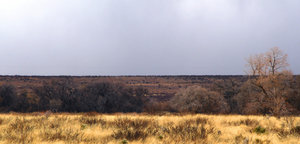Advertisement
Published: March 5th 2013

 MOWRY CITY
MOWRY CITY
From Demming take Hwy 180 about 16 miles northwest to Perrin Road. Turn right and go another five miles northward. Perrin Road is on the east side of the Mimbres River and the townsite and stage station were on the west side. There is no access to the area on the west side of the river, and private property between Perrin Road and the river. You might be able to get access to cross the private property from the Stockton Ranch. The townsite was most likely on the low bench below the bluff. Such as it was, Mowry City sprung into existence in 1859 at the Mimbres River Station on the Butterfield Trail. It was one of the earliest land scams in the American Southwest. Sylvester Mowry was a well-known advocate for separate territorial status for Arizona. To do so he was in the habit of making wildly exaggerated claims about population density, mineral wealth, and a salubrious climate well suited to the propagation of the species. In 1858 Mowry travelled by stage from Arizona to Missouri seeking financial backing for his mine. Along the way he met a man named Robert P. Kelley from Mesilla who had similar interests but fewer scruples. When Kelley returned to Mesilla after his business trip he got some pals, Samuel J. Jones and Lewis S. Owings interested in a plan to start up a new city. It was to become the capitol city of Arizona Territory, and they decided to take advantage of the already established Mowry name recognition. In 1859 Kelley and his partners published a pamphlet called “Report of the Mowry City Association, Territory of Arizona, for 1859”. The report was published in Palmyra, Missouri where Kelley had a brother-in-law named D. W. Hughes. Hughes also published a newspaper called the Mesilla Miner. Both the report and newspaper were a complete pack of lies. They greatly misrepresented the resources and potential of their not-yet-built-community and portrayed it as being peaceful and thriving. In truth all that thrived there were hostile Apaches, cactus, and rattlesnakes. In spite of itself Mowry City did attract a small amount of investment and growth, abetted by the discovery of placer gold at Pinos Altos in 1860. One of the struggling settlers at Mowry City was a man named Sherrod Hunter. The Apaches went on a rampage following the Bascom Affair in February of 1861 and Sherrod joined a sort of unofficial militia outfit up in Pinos Altos. They called themselves Rangers and Sherrod was elected to lead them. When the War Between the States reached New Mexico those Rangers joined the Confederate army, and were sent to take possession of southern Arizona. Mowry City struggled along without him forevermore. When the railroad came through it became a ghost town.
The following description of Mowry City has down through history in the journal of Loreta Janeta Velasquez:
Striking south-westward from Fort McRae we came to Rio de los Mimbres, near the head of which is Mowry City, founded by Lieutenant Mowry, who could not have had any very clear ideas as to what he was about when he attempted to make a settlement in such a place. Mowry City has a hotel, one or two stores, and more drinking-saloons than do it any good. That it will ever be much of a place I do not believe. There is not water enough in the river the greater part of the time to float two logs together, and in very dry weather one can step across it without wetting the feet. A sudden shower will, however, convert this puny creek in a short time into a raging river, which carries everything before it, and then it will subside as suddenly as it arose.
Loreta was mistaken about Sylvester Mowry’s involvement in the venture. The photo shows the town site across the river where nothing now remains.
Advertisement
Tot: 0.217s; Tpl: 0.01s; cc: 12; qc: 51; dbt: 0.1141s; 1; m:domysql w:travelblog (10.17.0.13); sld: 1;
; mem: 1.1mb

 MOWRY CITY
MOWRY CITY